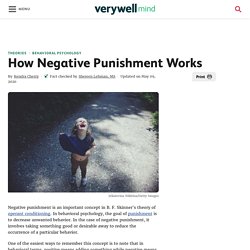

During this time, parents may feel a lack of ability/challenge to deal with the changes in the behaviour of their teenage child. What is Operant Conditioning? Operant Conditioning- BF Skinner. What is Reinforcement? What is Punishment? Chart example for Positive/Negative Reinforcement & Positive/Negative Punishment. Here is a video to understand Reinforcement and Punishment further. What does Reinforcement & Punishment means to parents? Using Positive Reinforcement. Parenting A Teen Through Positive Reinforcement - Back On Track. Most parents can agree: the teenage years can be rough!

Hormones are raging, they are trying to gain more independence, and they spend a lot of time away from their parents and their home while hanging with friends. One minute they love and adore you, the next minute you ruined their life. Can many of you relate? When tempers flare and disagreements are happening, it’s hard to not resort to yelling and harsh discipline, but studies are showing us that positive reinforcement may be the key to success, not just in the home but also in their school life.
Video for parents about Positive Reinforcement. Using Negative Reinforcement. Video for parents about Negative Reinforcement. Using Positive Punishment. Elaboration on Positive Punishment. Punishment is a fundamental concept used in the theory of Operant conditioning. The main objective of a punishment is to decrease the rate of certain undesired behavior from occurring again.
Among the two kinds of punishment, Positive and Negative, we are going to discuss Positive punishment in this article. Positive punishment is the part of punishment, which also focuses on decreasing the rate of any specific undesired behavior from an individual. Using Negative Punishment. What is Negative Punishment (Examples and Effectiveness) In this article, we will review negative punishment, its definition, examples, and drawbacks.

American psychologist B.F. Skinner developed the theory of operant conditioning, which stated that a person or animal’s behavior could be increased or decreased by adding or removing appropriate stimuli after the behavior is exhibited. The difference between classical conditioning and operant conditioning is that classical affects unconscious behavior, while operant affects conscious behavior. How Negative Punishment Works. Negative punishment is an important concept in B.

F. Skinner's theory of operant conditioning. In behavioral psychology, the goal of punishment is to decrease unwanted behavior. In the case of negative punishment, it involves taking something good or desirable away to reduce the occurrence of a particular behavior. One of the easiest ways to remember this concept is to note that in behavioral terms, positive means adding something while negative means taking something away. Consequence of using Punishment. Conclusion. The Difference between Positive/Negative Reinforcement and Positive/Negative Punishment and which is more effective. February 5, 2013 7:40 pm Published by Kelley Prince M.A., BCBA In Applied Behavior Analysis, there are two types of reinforcement and punishment: positive and negative.

It can be difficult to distinguish between the four of these. Therefore, the purpose of this blog is to explain the differences in order to help parents and professionals develop appropriate interventions to improve behavior. Reinforcement. Reinforcement and Punishment ( Talks about some Consequence about Punishment Method ) Learning Objectives Explain the difference between reinforcement and punishment (including positive and negative reinforcement and positive and negative punishment)Define shapingDifferentiate between primary and secondary reinforcers In discussing operant conditioning, we use several everyday words—positive, negative, reinforcement, and punishment—in a specialized manner.

In operant conditioning, positive and negative do not mean good and bad.